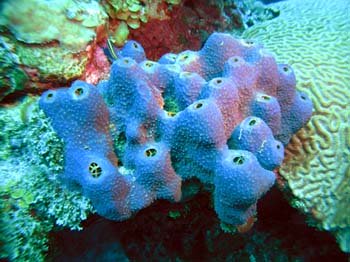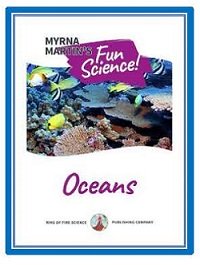Did you know Marine Sponges are animals?
Marine sponges resemble plants
Marine sponges are sessile animals that look like plants. They attached themselves to a rock, shell or seafloor when they are young and there live for the rest of their lives. They filter water through their porous body for the food they eat. They eat bacteria and other particles floating in the water as it moves through their body. They live on the seafloor in tide pools and the ocean floor after the larvae attaches itself to a surface where they live the rest of their life. Some sponges have been found living on ocean floors that are up to 8,800 meters (5.5 miles) deep.

Branching tube sponge, NOAA
5,000 species of sponges
There are over 5,000 named species with 99% of them living in salt water. Most marine sponges live in warm tropical waters. The fertilized eggs of sponges form larvae which live as plankton until they find a suitable place to settle and grow into an adult sponge.
Sponges are the simplest multicellular animals
Sponges are the simplest of multicellular animals with bodies full of pores. They do not have heads, arms or internal organs. Instead, they have water flowing through their body up to 20,000 times their own volume each day. The water contains plankton, bacteria and oxygen they need to survive.

Our fascinating Oceans book contains 15 chapters filled with information and activities about the oceans. Learn about fascinating recently discovered information about the oceans because 95% of the oceans and 99% of the seafloor was unexplored according NOAA. Myrna Martin

Click for More Information and to Order
How sponges filter water
The water is pulled into the sponges bodies through tiny pores that cover the outer surface of their body. Cells inside their body filter food from the water. Flagella pushes the water through canals in one direction as the sponges get their nutrition and oxygen before the water exits their body at another opening the oscula. The oscula is a large opening in the sponge’s body.
All marine sponges belong to phylum Porifera
All marine sponges belong to the phylum porifera
All marine sponges belong to phylum Porifera. They come in a wide variety of shapes, sizes and colors. Some marine sponges form encrusting sheets on rocks while other create volcano-shaped mounds. Their tubes that the water flows through can be as small as one millimeter or as large as one meter. Their colors include gray, red, yellow and blue. Algae grows on some of them giving them a green color.
Sponges eat organic carbon
A marine sponge that lives in deep cavities in coral reefs gets its nutrition from organic carbon that is inedible to most coral reef inhabitants. The sponge absorbs and uses 50% of its body weight each day to make new cells.
Researchers found the sponges didn’t grow in size but instead shed a large number of cells each day that provided nutrients for other coral reef inhabitants. The sponges are essentially recycling organic carbon that is used by other reef inhabitants.
Sponges use chemical compounds for protection
Sponges are also being studied by biologists because many species have developed a wide variety of chemical compounds to protect them from their enemies. Sponges have been found to produce more elaborate compounds than any other animals living around coral reefs.
Many of these chemical compounds are used as a type of chemical warfare against other animals that are encroaching on where they live. Today scientists are hoping to use some of these chemical compounds to combat human cancers and to use them in other medicines that fight bacterial diseases.
KIDS FUN Science Bookstore
Check out Myrna Martin's award winning textbooks, e-books, videos and rock sets. The Kids Fun Science Bookstore covers a wide range of earth science topics. Click here to browse.










